Comments / Questions (19)
![]() Eva Albinsson wrote:
Eva Albinsson wrote:
Hej! Förstår inte instruktionen för ögonen på renen. Krävs nog en film på momentet. Mvh Eva
11.12.2024 - 22:58DROPS Design answered:
Hej Eva, det har vi, klik på Videoer øverst i mønsteret og vælg den første video :)
12.12.2024 - 14:47
![]() Karin Neumann wrote:
Karin Neumann wrote:
Auf dem Bild sieht die Schnauze aus, als wäre diese glatt links gestrickt, in der Beschreibung bzw. Strickschrift ist jedoch kein Hinweis
31.10.2024 - 21:21DROPS Design answered:
Liebe Frau Neumann, die Schnauze wurde glatt rechts gestrickt - siehe unser DROPS-Along. Viel Spaß beim Stricken!
01.11.2024 - 08:32
![]() Laura wrote:
Laura wrote:
Når du sier «øk på hver annen pinne» betyr det at man strikker vrang = 1 pinne så øker man maske = 2 pinne på rett siden. Dvs at man øker på hver rett pinne? Takk
24.10.2024 - 07:30DROPS Design answered:
Hej Laura, ja hvis du strikker frem og tilbage på pinden, så bliver hver 2.pind til hver pind fra retsiden (eller vrangen hvis du starter med at øke på den) :)
24.10.2024 - 08:40
![]() Gudrun wrote:
Gudrun wrote:
Ich möchte zwei Pullover stricken, einen in M und einen in L. Benötige ich dann genau die Mengenangaben wie in der Anleitung oder genügen in den Beigetönen, dem Braun und dem Ocker ggfs. gesamt 50 g?
27.07.2024 - 19:46
![]() Gudrun wrote:
Gudrun wrote:
Ich möchte zwei Pullover stricken, einen in M und einen in L. Benötige ich dann genau die Mengenangaben wie in der Anleitung oder genügen in den Beigetönen, dem Braun und dem Ocker ggfs. gesamt 50 g?
27.07.2024 - 19:40DROPS Design answered:
Liebe Gudrun, am besten kalkulieren Sie die genaue Garnmenge beide Größe zusammen, so sind Sie sicher, Sie haben genügend Garn - sonnst kann Ihnen auch gerne Ihr DROPS Händler damit weiterhelfen. Viel Spaß beim Stricken!
29.07.2024 - 11:40
![]() Orlidolette wrote:
Orlidolette wrote:
Bonjour, Pourquoi ne pas pouvoir le faire en circulaire ? J’ai peut être raté un épisode qui explique pourquoi le faire en aller-retours obligatoirement ? Merci d’avance !
07.08.2022 - 18:12DROPS Design answered:
Bonjour Orlidolette, on tricote le devant et le dos séparément en allers et retours parce que le jacquard est de type "intarsia" et que ce type de jacquard se tricote est plus facilement en rangs qu'en rond (on peut ainsi tricoter plusieurs couleurs en même temps avec plusieurs pelotes, sans avoir à faire suivre le fil - cf vidéo). Bon tricot!
08.08.2022 - 07:43
![]() Nora wrote:
Nora wrote:
Hola como tejo este sueter con agujas del No. 4 talla chica? Con 22 puntos me dan 10 cm
10.10.2021 - 18:25DROPS Design answered:
Hola Nora, no hacemos patrones personalizados. En el caso de tener 22 puntos en 10 cm, se puede usar una aguja más grande, para tener menos puntos en 10 cm. En otro caso, tienes que hacer tú los cálculos de los puntos necesarios en cada paso, teniendo en cuenta el patrón y la tensión indicada ( 16 puntos en 10 cm).
10.10.2021 - 23:35
![]() FLORINE BIHLER wrote:
FLORINE BIHLER wrote:
Avec le modèle de motif une rangée de petits carreaux est-elle considérée comme endroit et envers ? Merci de votre réponse.
06.02.2021 - 10:12DROPS Design answered:
Bonjour Florine, ces symboles montrent les couleurs du jacquard. Le pull est tricote en jersey endroit (a l’endroit sur l’endroit et a l’envers sur l’envers de l’ouvrage) avec 1 maille lisière au point mousse. Bon tricot!
06.02.2021 - 19:25
![]() Sima wrote:
Sima wrote:
Bonsoir quand vous dites mesurer l’ouvrage désormais à partir d’ici après les augmentations des emmanchures et que vous dites continuez en jersey les A.1a et À.1b et continuez jusqu’à ce que l’ouvrage mesure 25 cm. Pour faire les augmentations est ce que les 25 cm à partir des augmentations des emmanchures ou bien à partir du début 2) qcq Vs voulez dire faire des augmentations à intervalles réguliers merci beaucoup pour votre aide
29.12.2020 - 19:33DROPS Design answered:
Bonjour Sima, vous mesurez pour le devant à partir des mailles montées pour les emmanchures de chaque côté - cf schéma: le bas du pull mesure 25 cm dans toutes les tailles à partir des emmanchures + les côtes du bas. Après ces 25 cm, vous tricotez 1 rang en augmentant à intervalles réguliers puis continuez en côtes pendant 6 cm. Bon tricot!
04.01.2021 - 11:57
![]() Sara wrote:
Sara wrote:
Buonasera, X la misura xxl a che ferro comincia il disegno marrone. .. (le corna? )grazie Sara
24.11.2020 - 17:34DROPS Design answered:
Buonasera Sara, il motivo sono A.1A e A.1B sul davanti e A.2A e A.2B sul dietro per tutte le taglie. Le corna iniziano sul 1° ferro. Buon lavoro!
24.11.2020 - 21:31
Red Nose Jumper#rednosejumper |
|||||||||||||||||||
 |
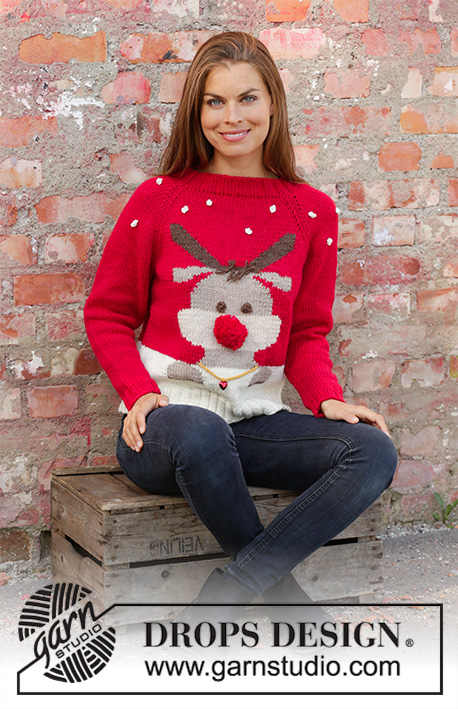 |
||||||||||||||||||
Knitted sweater in DROPS Nepal. The piece is worked top down with raglan and reindeer motif. Sizes S - XXXL. Theme: Christmas.
DROPS 194-38 |
|||||||||||||||||||
|
------------------------------------------------------- EXPLANATIONS FOR THE PATTERN: ------------------------------------------------------- RIDGE/GARTER STITCH (worked back and forth): 1 ridge = Knit 2 rows. PATTERN: See diagrams A.1 to A.3. Diagram A.3 shows a knot (= eyes and snowflakes). Diagrams A.1 and A.2 (reindeer): The whole diagram is worked in stockinette stitch. Work with 3/5 balls so you avoid long strands on the wrong side. In other words, work with 1 ball red/off white on each side of the sweater and 1 ball of the pattern color in the middle. NOTE: To avoid holes when changing colors, twist the strands together. INCREASE TIP (for raglan): All increases are worked from the right side! Work 1 edge stitch in garter stitch, knit 1, 1 yarn over, work until there are 2 stitches left, 1 yarn over, knit 1, 1 edge stitch in garter stitch. On the next row, purl the yarn overs twisted to avoid holes. Then work the new stitches in stockinette stitch. DECREASE TIP (for sleeves): All decreases are worked from the right side! Decrease as follows after the 1 edge stitch: Slip 1 stitch as if to knit, knit 1 and pass the slipped stitch over the knitted stitch. Decrease as follows before the 1 edge stitch: Start 2 stitches before the edge stitch and knit 2 together. ------------------------------------------------------- START THE PIECE HERE: ------------------------------------------------------- SWEATER - SHORT OVERVIEW OF THE PIECE: The piece is worked back and forth with circular needle, top down. Front and back pieces (with or without a reindeer on the back piece) and the sleeves are worked separately, back and forth. This makes working the pattern easier. Then the pieces are sewn together, stitch for stitch along the raglan-increases and sides. The neck is worked in the round and the sweater is decorated with nose, eyes, hair, snowflakes and necklace to finish. FRONT PIECE: Cast on 28-30-32-34-36-38 stitches (including 1 edge stitch in garter stitch on each side) with circular needle size 5.5 mm = US 9 and red. Purl 1 row from the wrong side. Then work stockinette stitch with 1 edge stitch in GARTER STITCH - read description above, on each side. At the same time, on the first row from the right side increase 1 stitch on each side for raglan - read INCREASE TIP. Increase like this every 2nd row a total of 20-21-23-25-27-29 times = 68-72-78-84-90-96 stitches. REMEMBER THE KNITTING GAUGE! AT THE SAME TIME when you have increased 7-7-8-9-10-10 times on each side and there are 42-44-48-52-56-58 stitches on the needle, work pattern as follows: 1 edge stitch in garter stitch, knit 1, 1 yarn over (= increase), knit 0-1-3-5-7-8, work A.1A (= 38 stitches) - read PATTERN above, knit 0-1-3-5-7-8 stitches, 1 yarn over (= increase), knit 1 and 1 edge stitch in garter stitch = 44-46-50-54-58-60 stitches. When all the increases to raglan are finished, the piece measures approx. 20-21-23-25-27-29 cm = 8"-8¼"-9"-9¾"-10⅝"-11⅜". At the end of the next 2 rows cast on 4-5-5-5-7-9 stitches for the armhole on each side of the piece = 76-82-88-94-104-114 stitches. THE PIECE IS NOW MEASURED FROM HERE! Continue with stockinette stitch, pattern and 1 edge stitch in garter stitch on each side. When A.1A has been completed, work A.1B over A.1A. On the row with an arrow in A.1B change the background color to off white instead of red and the pattern will now be worked over 42 stitches. When A.1B has been completed in height continue with off white, stockinette stitch and 1 edge stitch in garter stitch on each side until the piece measures 25-25-25-25-25-25 cm = 9¾"- 9¾"- 9¾"- 9¾"- 9¾"- 9¾". Now increase 16-18-20-22-24-26 stitches evenly on row = 92-100-108-116-128-140 stitches. Change to circular needle size 4.5 mm = US 7 and work rib as follows from the right side: 1 edge stitch in garter stitch, (knit 2, purl 2) until there are 3 stitches left on the row, knit 2 and 1 edge stitch in garter stitch. Continue like this until the rib measures 6 cm = 2⅜". Bind off with knit over knit and purl over purl. The front piece measures 51-52-54-56-58-60 cm = 20"-20½"-21¼"-22"-22¾"-23⅝" from the neck down. Cut and fasten the strand. BACK PIECE – WITH REINDEER: Cast on and work in the same way as the front piece, but work pattern A.2A instead of A.1A and pattern A.2B instead of A.1B. When A.2B has been completed in height, continue with off white, stockinette stitch and 1 edge stitch in garter stitch on each side until the piece measures 25-25-25-25-25-25 cm = 9¾"- 9¾"- 9¾"- 9¾"- 9¾"- 9¾" – adjust to match the front piece. Now increase 16-18-20-22-24-26 stitches evenly on row = 92-100-108-116-128-140 stitches. Change to circular needle size 4.5 mm = US 7 and work rib as follows from the right side: 1 edge stitch in garter stitch, (purl 2, knit 2) until there are 3 stitches left on the row, purl 2 and 1 edge stitch in garter stitch. Continue like this until the rib measures 6 cm = 2⅜". Bind off with knit over knit and purl over purl. The back piece measures 51-52-54-56-58-60 cm = 20"-20½"-21¼"-22"-22¾"-23⅝" from the neck down. Cut and fasten the strand. BACK PIECE - WITHOUT REINDEER: Cast on 28-30-32-34-36-38 stitches (including 1 edge stitch in garter stitch on each side) with circular needle size 5.5 mm = US 9 and red. Purl 1 row from the wrong side. Then work stockinette stitch with 1 edge stitch in garter stitch on each side. At the same time on the first row from the right side increase 1 stitch on each side to raglan - remember INCREASE TIP. Increase like this every 2nd row a total of 20-21-23-25-27-29 times = 68-72-78-84-90-96 stitches. When all the increases to raglan are finished, the piece measures approx. 20-21-23-25-27-29 cm = 8"-8¼"-9"-9¾"-10⅝"-11⅜". At the end of the next 2 rows cast on 4-5-5-5-7-9 stitches for the armhole on each side of the piece = 76-82-88-94-104-114 stitches. THE PIECE IS NOW MEASURED FROM HERE! Continue with stockinette stitch and 1 edge stitch in garter stitch on each side. When the piece measures 18-17-16-15-14-12 cm = 7"-6¾"-6¼"-6"-5½"-4¾" – adjust to after the change in background color on the front piece, continue with off white to finished length. When the piece measures 25-25-25-25-25-25 cm = 9¾"- 9¾"- 9¾"- 9¾"- 9¾"- 9¾" – adjust to match the front piece, increase 16-18-20-22-24-26 stitches evenly on row = 92-100-108-116-128-140 stitches. Change to circular needle size 4.5 mm = US 7 and work rib as follows from the right side: 1 edge stitch in garter stitch, (knit 2, purl 2) until there are 3 stitches left on the row, knit 2 and 1 edge stitch in garter stitch. Continue like this until the rib measures 6 cm = 2⅜". Bind off with knit over knit and purl over purl. The back piece measures 51-52-54-56-58-60 cm = 20"-20½"-21¼"-22"-22¾"-23⅝" from the neck down. Cut and fasten the strand. SLEEVE: Cast on 14 stitches (including 1 edge stitch on each side) with circular needle size 5.5 mm = US 9 and red. Purl 1 row from the wrong side. Then work stockinette stitch with 1 edge stitch in garter stitch on each side. AT THE SAME TIME on the first row from the right side increase 1 stitch on each side - remember INCREASE TIP. Increase like this every 2nd row a total of 19-21-23-24-24-25 times = 52-56-60-62-62-64 stitches. Continue working with stockinette stitch until the sleeve measures 20-21-23-25-27-29 cm = 8"-8¼"-9"-9¾"-10⅝"-11⅜". Now cast on 4-5-5-5-7-9 new stitches for the armhole at the end of the next 2 rows = 60-66-70-72-76-82 stitches. THE PIECE IS NOW MEASURED FROM HERE! Continue with stockinette stitch and 1 edge stitch in garter stitch on each side. When the piece measures 4 cm = 1½" decrease 1 stitch on each side - read DECREASE TIP. Decrease like this every 2-2-2-1-1-1 cm = ¾"-¾"-¾"-⅜"-⅜"-⅜" 4-13-15-7-12-14 times and then every 3-3-3-2-2-2 cm = 1⅛"-1⅛"-1⅛"-¾"-¾"-¾" 9-2-1-10-6-6 times = 34-36-38-38-40-42 stitches. Continue working until the sleeve measures 40-39-38-36-34-33 cm = 15¾"-15¼"-15"-14¼"-13⅜"-13". Now increase 4-6-4-4-6-8 stitches evenly on row = 38-42-42-42-46-50 stitches. Change to circular needle size 4.5 mm = US 7 and work rib as follows from the right side: 1 edge stitch in garter stitch, (knit 2, purl 2) until there is 1 stitch left on the row, 1 edge stitch in garter stitch. Continue like this until the rib measures 4 cm = 1½". Bind off with knit over knit and purl over purl for 4 cm = 1½" - make sure that the bind-off edge is not tight. Work the other sleeve in the same way. ASSEMBLY: Sew the sleeves to the front and back pieces - sew inside the 1 edge stitch in garter stitch. NOTE! Make sure that the seam is not tight! Sew the sleeve and side seams in one go, inside the 1 edge stitch. Sew together the hole under the sleeve. NECK: Knit up from the right side 1 stitch in each stitch (but not in the edge stitches on the sides of the pieces) with short circular needle size 4.5 mm = US 7 and red = 76-80-84-88-92-96 stitches. Knit 1 round where you increase 4 stitches evenly on round = 80-84-88-92-96-100 stitches. Work rib (knit 2, purl 2) for 4 cm = 1½". Bind off with knit over knit and purl over purl - make sure that the bind-off edge is not tight. NOSE: Make a pom pom with red of approx. 7 cm = 2¾" in diameter. Shape the pom pom into an oval, so that it is approx. 7 cm = 2 3/4» one way and approx. 5 cm = 2" the other way; remember to leave 2 strands to fasten the pom pom with. Place the pom pom on the front of the reindeer’s head, just above the middle of the light beige section – see photo. Thread the strand ends through the garment on each side of one stitch and tie together on the wrong side. EYES: Make 2 eyes with medium brown as follows: 1 eye: Cut 3 strands of approx. 40 cm = 15¾". Make 4 knots around a needle size 5 mm = US 8 - see diagram A.3 (i.e. make 3 LOOSE knots, then 1 more knot and tighten the strand on this knot = 1 knot). Make 1 more eye. Place the eyes on the front of the reindeer’s head, just above the light beige section - see photo. Thread the strand ends through the garment on each side of one stitch and tie together on the wrong side. HAIR: Fasten 4 fringes for hair both on the on front and back of head. 1 fringe = cut 2 strands medium brown of approx. 8-9 cm = 3⅛"-3½". Lay the 2 strands together, thread them around one stitch at the top of the head, between the beige on the head and the medium brown on the antlers - middle of the head itself. Tie a double knot. Fasten the other fringes in the same way – see photo. NECKLACE IN FRONT: Work a row of chain stitches of approx. 18-19 cm = 7"-7½" with hook size 4 mm = US 6 and goldenrod. Thread a red heart or something similar onto the row of chain stitches and tie a knot so that it stays in the middle of the row. Place the necklace across the reindeer’s neck on the front piece. Fasten the strand ends on the wrong side of the garment. NECKLACE AT BACK: Work a row of chain stitches of approx. 15 cm = 6" with hook size 4 mm = US 6 and goldenrod. Place the necklace across the reindeer’s neck on the back piece. Fasten the strand ends on the wrong side of the garment. SNOW: Make approx. 16 knots with off-white for the snow. 1 knot: Cut 1 strand of approx. 40 cm = 15¾". Make 4 knots around needle size 5.5 mm = US 9 - see A.3 (i.e. make 3 LOOSE knots, make 1 more knot and tighten the strand on this knot = 1 knot). Place the snowflakes on the top section of the yoke, i.e. 4 snowflakes on the front piece, 5 snowflakes on the back piece, 4 snowflakes on the left sleeve and 3 snowflakes on the right sleeve. Thread the strand ends through the garment on each side of one stitch and tie together on the wrong side. |
|||||||||||||||||||
Diagram explanations |
|||||||||||||||||||
|
|||||||||||||||||||
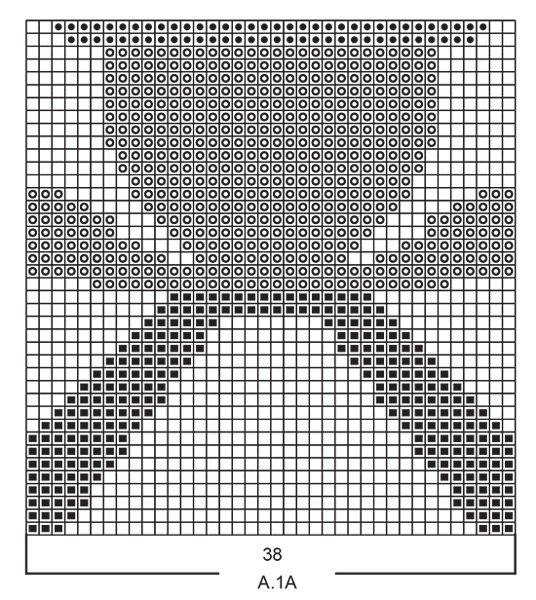
|
|||||||||||||||||||
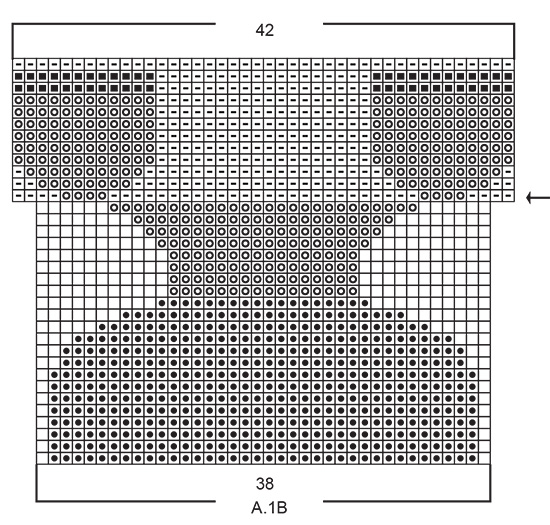
|
|||||||||||||||||||
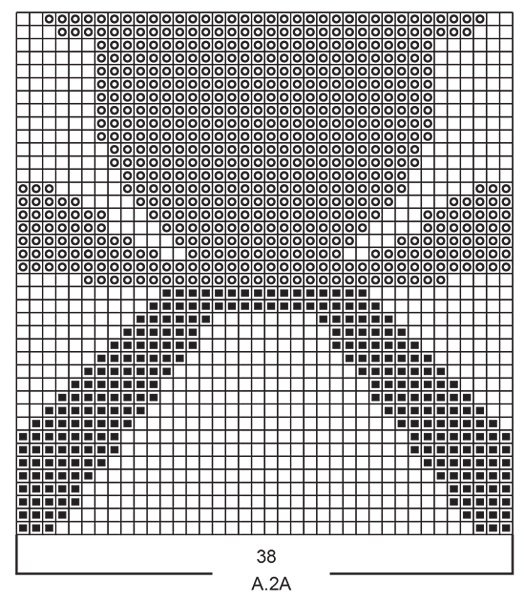
|
|||||||||||||||||||
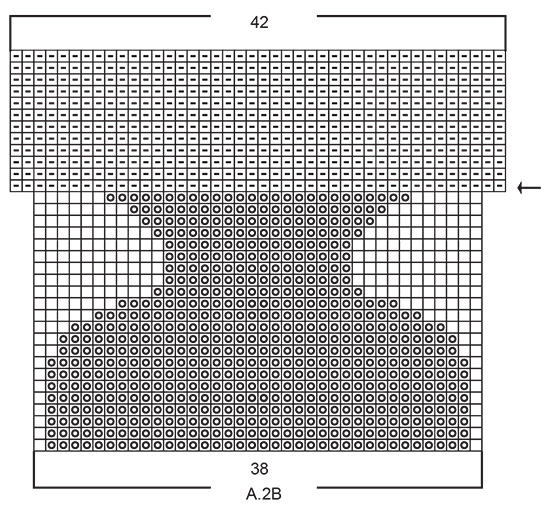
|
|||||||||||||||||||
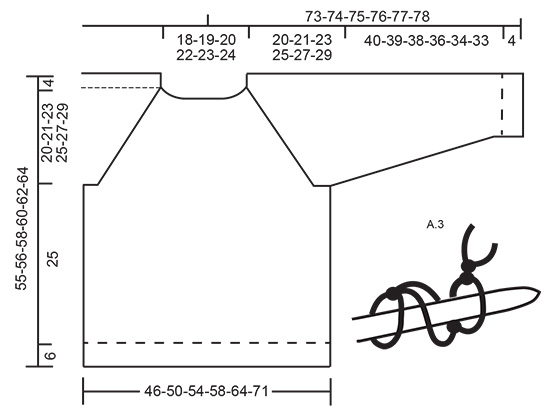
|
|||||||||||||||||||
Have you finished this pattern?Tag your pictures with #dropspattern #rednosejumper or submit them to the #dropsfan gallery. Do you need help with this pattern?You'll find 29 tutorial videos, a Comments/Questions area and more by visiting the pattern on garnstudio.com. © 1982-2025 DROPS Design A/S. We reserve all rights. This document, including all its sub-sections, has copyrights. Read more about what you can do with our patterns at the bottom of each pattern on our site. |
|||||||||||||||||||







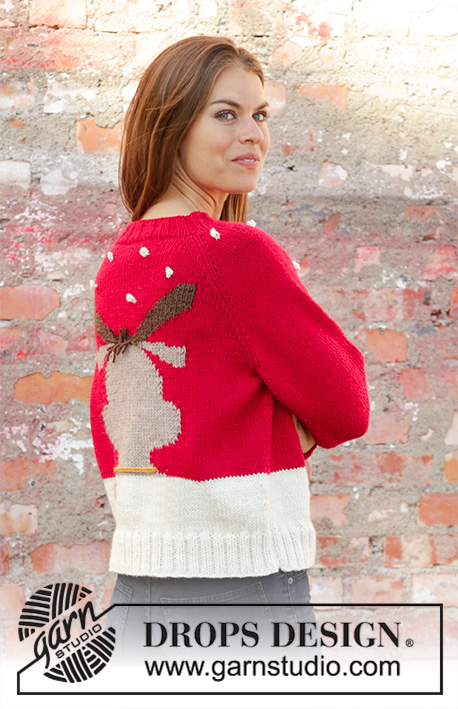
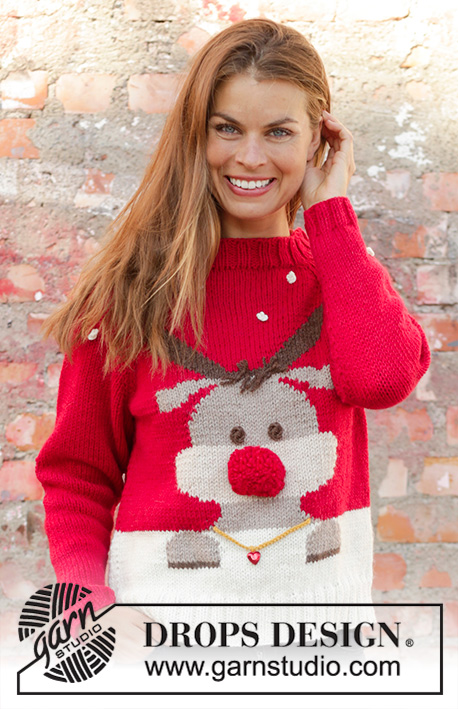

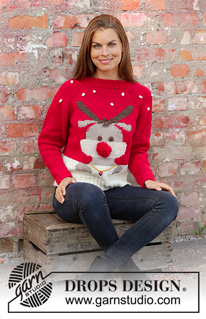
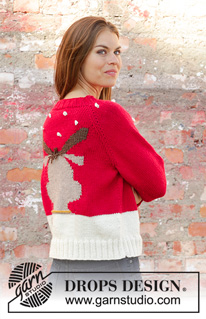
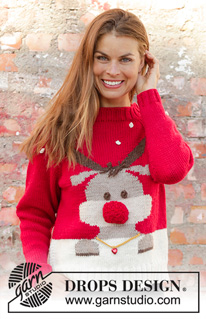






























































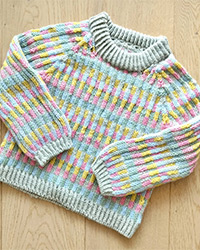
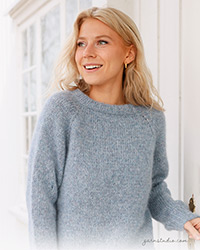


Post a comment to pattern DROPS 194-38
We would love to hear what you have to say about this pattern!
If you want to leave a question, please make sure you select the correct category in the form below, to speed up the answering process. Required fields are marked *.